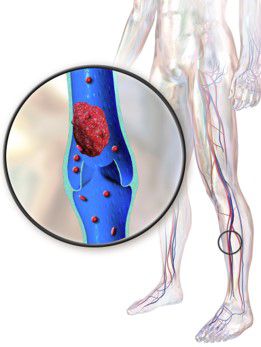
Most hospital surgeries require patients be put under general or epidural anaesthesia. Anaesthesia allows the patient to “sleep” through their procedures helping patients avoid both the physical and emotional stress of the operation. Anesthesia is also very important because it keeps the patient from moving during surgery. This “stillness” allows the surgeon to undertake their procedure without jeopardizing patient safety due to unwanted movement.
This same lack of movement, however might also cause other problems for the patient. The most concerning of these problems is the formation of a blood clot developing in the legs, or deep venous thrombosis (DVT) while the patient lies motionless on the table. In fact, in some surgical procedures (typically those lasting more than 3 hours, those involving bones or the back, or those done to treat a cancer) the risk of developing a blood clot can be as high as 80%. For that reason, national guidelines recommend that patients undergoing these long and complex surgeries (as well as some minor surgeries) are treated prophylactically- in advance- of a problem. This treatment can include the use of blood thinners before and after surgery, the use of compression pumps, and the use of early mobilization after surgery.

Blood clots that develop after a knee or hip surgery are also very common; unfortunately, these clots can be quite difficult to diagnose. One expects the affected joint to be painful and swollen after a procedure. Unfortunately, what could be a life threatening condition is often overlooked or misdiagnosed.
How can one know if post operative swelling is a part of the normal recovery or something more concerning? Only by getting a vascular ultrasound study can a definitive determination be made as to the presence or absence of a clot.
It is important to ask your surgeon to order an ultrasound if:
- You feel tenderness and swelling in your calf or thigh after a surgical procedure.
These symptoms last longer than what your doctor told you to expect.
These symptoms prevent you from performing the activities for recovery you expected to do.
A special note of caution: ultrasound studies can be done at the hospital or at a nearby vascular surgeon’s office where the technologists are specialists in examining the veins and arteries of patient’s legs for clots
At SBVC, we perform dozens of exams for DVT monthly; mostly for orthopedic surgeons, podiatrists, and primary care doctors who want fast and accurate results. We also help these doctors immediately start treatment should a DVT be diagnosed because we can evaluate their patients immediately and if necessary we can beginning them on blood thinners in the office. As vascular surgeons we are able to begin care immediately saving patients from an expensive, frustrating, and time-consuming visit to the emergency room. We are aware how difficult this unsuspected surgical complication can be, especially when you are still in pain and recovering, but, we do our best to help you through this unfortunate occurrence.
If you experience any of the post surgical complications outlined above and suspect that it may be a blood clot, contact your surgeons office immediately to schedule an appointment.